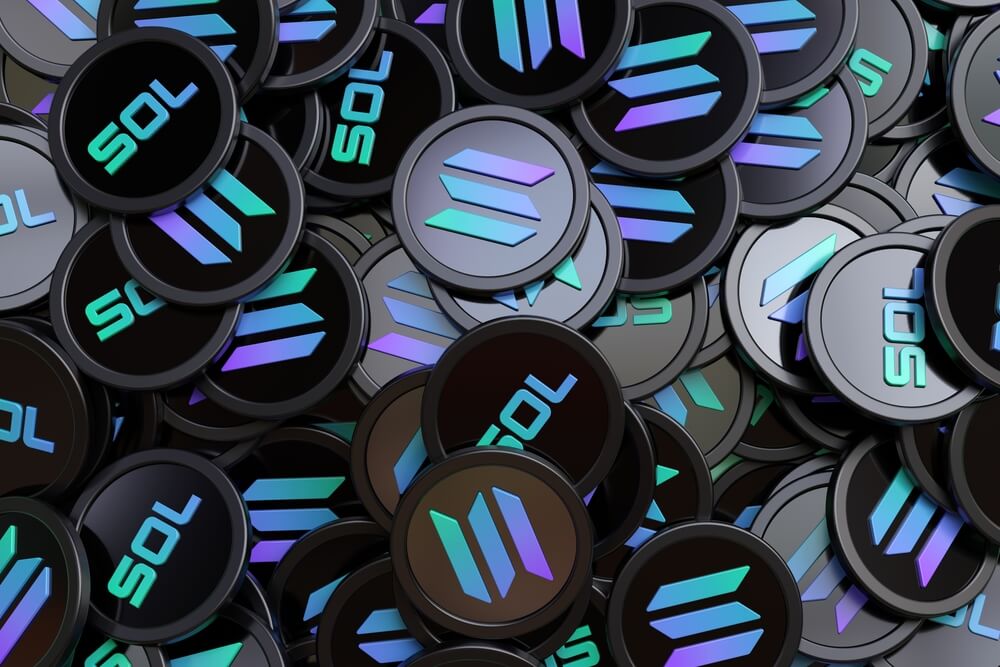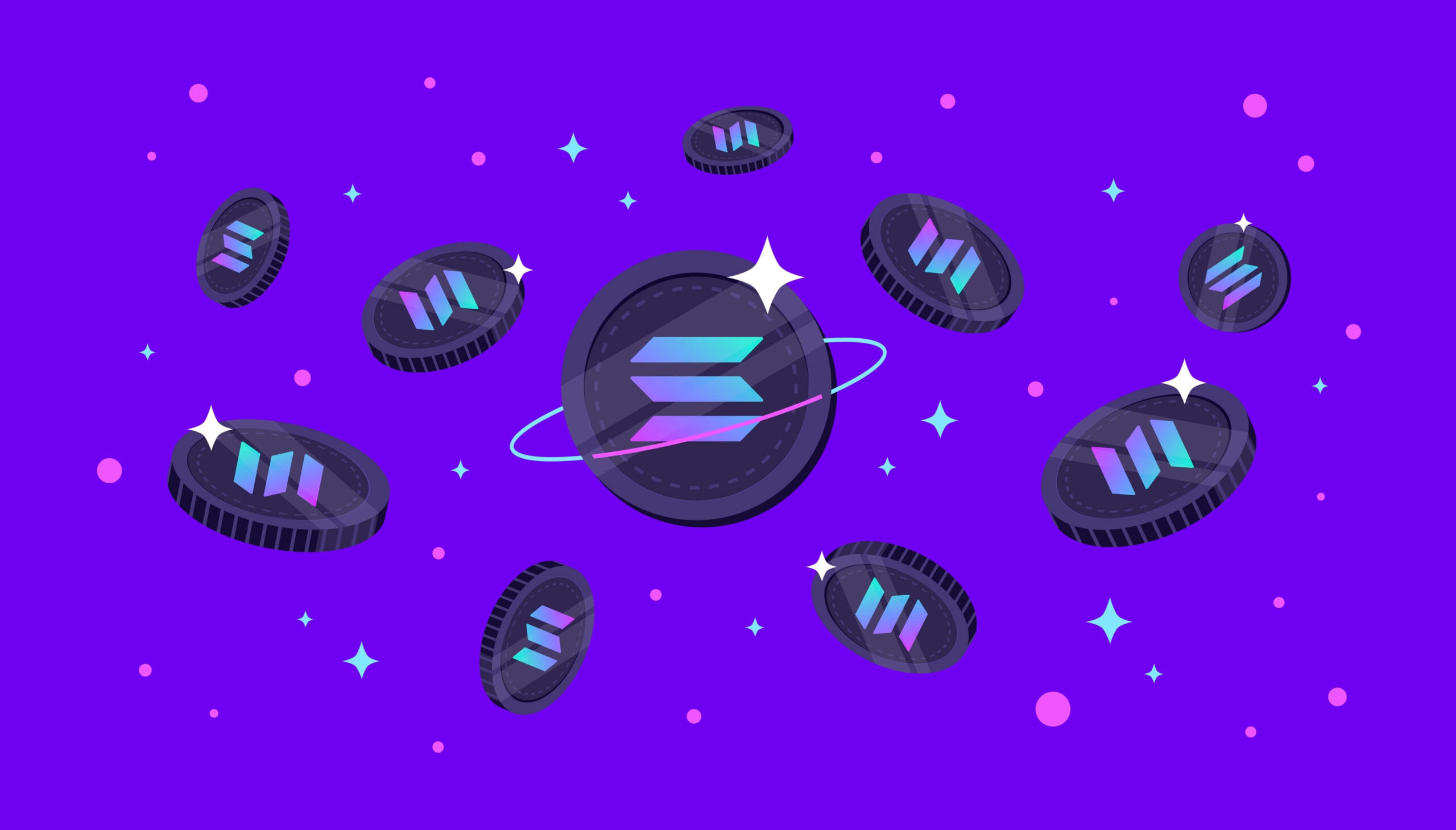Solana has been making a big splash into the crypto space with its capacity to process transactions at super high speeds.
In fact, Solana’s network is able to process over 65,000 transactions per second — that’s like being able to send a text message, tweeting about it, and posting your favourite funny cat video all at once!
But Solana isn’t just about speed, it’s also got some serious smarts. Solana’s unique architecture enables it to support decentralised applications (Dapps) and decentralised finance (DeFi) transactions needs, making it a versatile all-in-one platform.
In this article, we’re going to take a closer look at Solana, including its history and how it works. So grab a cup of coffee and let’s dive in to learn all about this exciting blockchain platform!
What Is Solana (SOL)?
The Solana token, also known as SOL, is a native token that powers the Solana blockchain, a high-performance platform that’s all about providing fast and efficient decentralised applications.
With SOL, you can pay for transaction fees, join in on the Solana ecosystem as a validator or staker, and even use it as a medium of exchange for all sorts of goodies, like goods, services, debt, and collateral for borrowing stablecoins on DeFi apps on Solana.
It’s no wonder Solana has caught the attention of all sorts of industries, like decentralised finance (DeFi), gaming, and social media. With its lightning-fast transaction speeds and low fees, it’s the perfect choice for DeFi applications.
Additionally, several popular DeFi projects have already been built on Solana, so you know it’s the real deal. And let’s not forget, Solana’s high performance has made it a go-to choice for gaming and even online gambling platforms who are looking to integrate with blockchain technology.
Solana shares many similarities with Ethereum as a blockchain network. Both platforms can host DApps, facilitate transactions on smart contracts, and have a diverse range of applications such as DeFi, censorship-resistant media, NFT art & token marketplaces, and also oracle networks.
From Idea to Reality: The History of Solana’s Creation
Solana is a project that was born out of a dream, and it’s one that has since become reality.
Originally founded by Solana Labs in San Francisco. A team of software engineers, led by Anatoly Yakovenko, had spent many years working at the Fortune 500 company Qualcomm, which provides semiconductors, software and wireless technology services for mobile phones. Qualcomm is based in San Diego, just slightly south of California’s Solana Beach—which then inspired the name of the crypto project.
The dream behind Solana began when Anatoly Yakovenko idealised a decentralised network of nodes that could keep up with the performance of a single node and published a white paper about it in November 2017. This paper described a technique called “proof-of-history“.
The journey to Solana’s success wasn’t always easy, though: in 2018, the team began their fundraising efforts, which resulted in a private Series A funding round that raised over $20 million.
But they didn’t stop there! They continued working hard and launched the mainnet on March 14th 2020. In addition to this success, they also raised an additional $1.76 million in a public token sale on CoinList – an auction platform for cryptocurrencies.
What makes Solana special, and how does it work?
Well, for starters, it can process up to 65,000 transactions per second—that’s more than 3000 times as fast as Ethereum. And this speed is achievable even with GPUs, so no fancy ASIC miners are necessary.
On top of that, Solana has a whole lot more features on Solana’s unique Network Architecture that make it stand out with these eight core components:
Proof of History (A clock before consensus)
Proof of History is like a special clock for the Solana blockchain. It helps all the computers on the network agree on when and in what order transactions happen. The network creates a very secure way to measure time, this way all the computers can agree on what time it is.
With Proof of History, we can get a special code that can be checked by anyone to make sure it’s correct. This way, the computers on the network don’t have to talk to each other as much, and that makes everything run faster and smoother.
Tower BFT (PoH-optimised PBFT)
Tower BFT is a special way for computers in a network to agree on something called Practical Byzantine Fault Tolerance or PBFT. It’s an important part of understanding how Solana works and what it’s used for.
Tower BFT takes advantage of something called a synchronised clock in Proof of History networks, which allows it to reach a consensus without causing delays or extra messaging.
To put it simply, Tower BFT is a tool that helps all the computers in a network to agree and stay on the same page, even if some of them are not working properly or are trying to cause problems. It makes sure that everyone is on the same page, so the network can keep working smoothly and securely.
Turbine (A block propagation protocol)
Solana blockchain has this awesome feature called Turbine that helps to send information to the different parts of the network in a super easy way.
It’s like a traffic cop for a busy street, it helps to manage the flow of data packets to different nodes on the blockchain, so everything can be processed efficiently. By breaking the data into smaller packets, Turbine helps to reduce the pressure on the network’s bandwidth and makes everything go faster.
This means Solana can process more transactions per second, making it super speedy and efficient. It can handle lots of transactions and users at once, making it perfect for decentralised applications that need a lot of power and scalability. So, Turbine is a real lifesaver for Solana blockchain, helping it to run smoothly and efficiently.
Gulf Stream (The Mempool-less Transaction Forwarding Protocol)
Gulf Stream is another cool feature in the Solana blockchain that helps make sure transactions are processed quickly and smoothly. It works by caching transactions at the edge of the network, which means that validators can start processing them before they are even confirmed. This helps to speed up the confirmation time and make sure that transactions are completed faster.
Gulf Stream also makes it easier for the network to switch between different leaders, and it helps to reduce the pressure on validators by keeping unconfirmed transactions separate. All of this together helps Solana to process a whopping 65,000 transactions per second.
That’s like a whole lot of transactions happening all at once, and Gulf Stream helps to keep everything organised and running smoothly. So, it’s a pretty important feature for Solana to have in order to keep up with the fast pace of the blockchain world.
Sealevel (A parallel Smart Contract Execution)
Sealevel for Solana blockchain is like a multitasking chef in a kitchen. Just as a chef can prepare multiple dishes simultaneously and manage different stations, Sealevel allows multiple smart contracts to be executed in parallel and manage multiple SSDs and GPUs, much like how a multitasking chef can increase the efficiency and output of a kitchen.
Sealevel also allows for concurrent execution of smart contracts on the same state blockchains, which helps to reduce confirmation times and increase the overall throughput of the network. This makes it an ideal solution for decentralised applications that require high scalability and performance. By utilising SeaLevel, Solana can handle a high number of transactions per second, making it more suitable for high-throughput use cases and running multiple smart contracts in parallel.
Pipeline (Unit for optimising validation processes)
Pipeline for the Solana blockchain is like a conveyor belt in a factory. Just as a conveyor belt moves products through different stations for processing, Pipeline moves transactions through different hardware components for validation and replication.
This helps to increase the overall performance of the network, much like how a conveyor belt can increase the efficiency and output of a factory.
Cloudbreak (Horizontal scaling database)
Cloudbreak for Solana blockchain is like a well-organised data centre. Just as a data centre can store and manage large amounts of data and be able to scale horizontally, Cloudbreak can store and manage large amounts of accounts on the blockchain and be able to scale horizontally.
It helps to keep the network running smoothly and effectively, like how a well-organised data centre can keep an organisation running well.
Archivers (Distributed ledger technology stores)
Archivers are a feature in the Solana blockchain that helps to store information in a distributed way. Think of them like a network of digital storage units, they help keep data from validators safe and secure.
The nodes or Archivers are lightweight, which means they’re easy to use and don’t take up a lot of space. They also go through audits to make sure that the data is accurate and reliable.
You can use Archivers—as a distributed ledger storage solution—to take the strain off of validators by moving data to a network of nodes, which helps to keep the data safe and secure.
It’s like storing your important documents in a safe deposit box, where it’s protected from potential damage or loss. Archivers help to increase the security of the network and ensure data integrity.
The final and most crucial highlight of the Solana ecosystem is the SOL token, the native currency in the network.
It can serve as a means of payment for running on-chain transactions or validating transactions. In addition, the SOL token also facilitates micropayments such as Lamport fees.
Storing your Solana (SOL) crypto wallets
Cryptocurrencies, including Solana (SOL), are stored in crypto wallets. These wallets contain two sets of keys, a public and a private key.
You can think of public keys like your email address, where anyone with that information can send and receive emails. Private keys are the unique identifying credentials that allow a user to access that email address – or in this case, your SOL tokens.
While there are many crypto wallets out there, the common distinction in wallets are between hot and cold wallets, as explained below – along with example wallets that support the secure storage of Solana.
- Hot wallets: perhaps the most popular storage method for many cryptocurrencies, including SOL. This type of wallet requires an active internet connection to manage and access your assets, hence the term hot. Easily accessible and user-friendly, and takes the form of applications on your mobile phone or computer. Examples of hot wallets that support SOL include: Trust Wallet and Exodus Crypto Wallet.
- Cold wallets: the most secure method of storing crypto, and takes the form of a hardware device. Not as readily accessible like the hot wallets, but offers maximum protection for those who intend to invest or trade in large volumes. Examples of cold wallets that support the storage of SOL include: Trezor and Ledger.
A Closer Look at Solana (SOL) Token Market Value
As of this publication, Solana is trading at $21.07 USD, and it has a 24-hour trading volume of $1,307,311,573 USD. The price of Solana is updated in real-time, so you can always stay on top of how much it’s worth.
Unfortunately, the coin has seen a 9.64% drop in the last 24 hours, which makes it a bit of a volatile digital asset.
According to CoinMarketCap, Solana is currently ranked at #11 with a live market cap of $7,815,519,805 USD, which means that all the Solana tokens currently in circulation are worth around 7.8 billion dollars.
The circulating supply of Solana today is 370,992,304 SOL coins, and the maximum supply is not available. This means that there is a finite number of Solana tokens that exist and will exist in the future, and can affect its market value.
The market value of Solana is determined by the supply and demand in the market, and it can fluctuate based on various factors such as news, adoption, and investor sentiment.
It’s important to track the market trends and developments to make informed investment decisions.
Solana in Online Gambling Industries
By the way, if you’ve used our payment methods before, you might have noticed that Solana SOL is one of the cryptocurrency options available to you among many others here on Gambulls crypto casino.

Solana is like the ultimate wingman for online crypto gambling – it’s reliable, efficient, and always has your back!
One of the biggest advantages of using Solana for online gambling is its lightning-fast transaction speeds and low fees, which means you can deposit and withdraw your funds quickly and easily. This makes the entire process more convenient and enjoyable for you.
However, it’s important to remember that cryptocurrencies are highly volatile assets, and their value can fluctuate greatly based on a variety of factors such as market sentiment, geopolitical events, institutional backing, community adoption, and more. Past performance does not guarantee future returns.
So, it’s always a good idea to do your own research and gain a deeper understanding of the context before investing in crypto or any other investment opportunity. This will help you make more informed decisions and reduce your risks in the long run.
Looking for Solana gambling? Visit Gambulls Casino to get started.

